EGYPT
PTOLEMY I, SOTER, 323-283 BC (satrap 323-305, king 305-283)
BERENIKE I, wife of Ptolemy I
|
CLEOPATRA OF EGYPT
9421. SCARCE PORTRAIT COIN OF THE FAMOUS CLEOPATRA OF EGYPT. CLEOPATRA VII, 51-30 BC. AE25 80 drachma, 16.67 g, BMC 4-5. Draped bust with diadem r./Eagle stg. on thunderbolt l., double cornucopia. RR! Good Fine with nice portrait for these which are almost always found in poor condition. This is an original contemporaneous portrait of the famous Cleopatra Thea, lover of Julius Caesar and Marc Antony.  $1100. $1100.
|
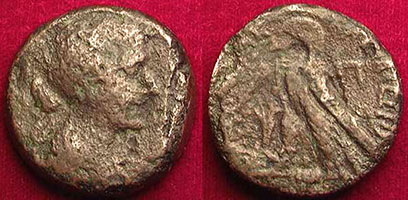
|
|
10505. EGYPT, PTOLEMAIC KINGS. BERENIKE I or II. Mid 3rd century BC. AR Didrachm (18mm, 6.56 g). Kyrene or Alexandreia mint. Diademed and draped bust right / Club facing downward; monogram to left, trident head to right; all within wreath. Svoronos 318 (Berenike I); Caltabiano, Berenice, pl. I, 3 (Berenike II); SNG Copenhagen 429 (Berenike I); cf. BMC Ptolemies p. 60, 13 (Berenike II); BMC Cyrenaica p. 76, 11 (Berenike I); Noske -. VF, lightly toned, porous. Considerably better than photo. Scarce Ptolemaic portrait coin as most Ptolemaic issues feature the head of Zeus rather than likenesses of Ptolemaic rulers.
These didrachms struck in the name of Berenike have been attributed to either Berenike I, wife of Ptolemy I, or Berenike II, wife of Ptolemy III. Even at the time of Svoronos' great corpus, there was no unanimity among prominent numismatists. While Svoronos favored an attribution to Berenike I, Poole (in BMC Ptol.), Head, and Muller preferred Berenike II. A full discussion of these attributions was taken up by Robinson in his introduction in BMC Cyrenaica (pp. cxlix-cliv). His argument supports an attribution to Berenike I, but much later than Svoronos' dating, to the period of Magas' revolt against Ptolemy II. His conclusions are largely based on the attribution of the bronze coinage in this period, and further refinements have necessitated a lowering of Robinson's dating, placing the Berenike coins in the period after the revolt, when Magas was reconciled to Ptolemy, circa 261-258 BC (cf. Buttrey, Coins, 199, and p. 55). Caltabiano, however, has assigned all of the coinage in the name of Berenike, both Egyptian and Kyrenaikan, to Berenike II, and dates them to the period that Berenike was regent while Ptolemy III was away fighting in the Third Syrian War. Much of her argument is based on control mark links she identifies between the Berenike coinage and that assigned to Ptolemy III and IV. Both theories have significant flaws. The attribution to Berenike I relies strongly on the dating of the bronze 'Koinon' coinage of Kyrenaika, but recent finds have suggested these issues may be later than previously thought. On the other hand, Caltabiano's linkage between the Kyrenaikan and Egyptian coinage in the name of Berenike is conjectural, and ignores the significance of the MAΓ monogram, which must be related to Magas (cf. BMC Cyr. p. cl). Perhaps the most important deficiency in analyzing this coinage is the absence of any known mixed-coinage hoard containing these didrachms. Discussion courtesy CNG.  $400. $400.
|
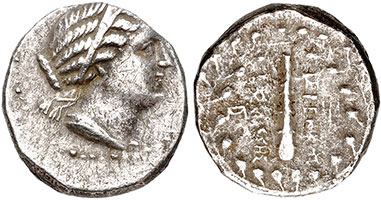
|
PTOLEMY II, PHILADELPHOS, 285-246
|
EXCELLENT EXAMPLE OF LARGEST & HEAVIEST EGYPTIAN COIN
9371. EGYPT, PTOLEMY III or IV, ca. 246-204 BC. AE42, Sear 7841v. Diademed head of Zeus Ammon right. / Eagle standing left on thunderbolt, cornucopia to l. VF+. Choice perfectly centered huge bronze close to 100 grams too heavy for my scale.
 $800. $800.
|
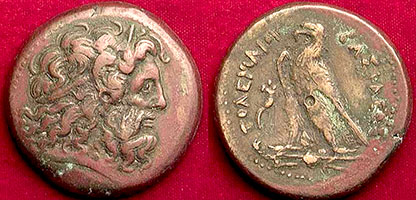
|
|
ONLY 10 KNOWN INCLUDING ONE IN THE BRITISH MUSEUM
10355. A VERY RARE PTOLEMAIC BRONZE. EGYPT, PTOLEMY II?, c. 260 BC. Middle Eastern? mint. AE19, 5.03 g. 12h. Svoronos 792 (Plate XXV, #22), BMC 65, #29. Svoronos knew only the single BMC example. Laur. hd. Zeus Ammon right. Reverse: Eagle standing left on thunderbolt looking left, tripod to left and Π-T-O monogram to right of eagle. VF. Nice dark glossy green patina. Much better than photo. Only a few examples known. Very rare and missing from most collections. Only 2 other examples known including one in the British Museum.
Svoronos attributes these to Ptolemy II but the details, of style, and lettering suggest even Ptolemy III or even Ptolemy V. The eagle is similar to those on Ptolemy V portrait tetradrachms. The Ptolemy V coins with NI controls are said to be from 'military mints' of the 4th or 5th Syrian war. Perhaps this tripod type has a similar origin (middle East) while the others (791, 793) are believed to come from Western Turkey (Bodrum, Fethiye). Richard Ashton wrote an article on those arguing for the Turkish mints. The Ashton paper on coins at Fethiye (turkey) does not include these types. The 791 and 793 are plentiful there but not 792 with the Π-T-O symbol. Interesting also that a couple of earlier issue Ptolemaic bronzes are known with a tripod countermark and perhaps are related to these. One is a Tyre coin of Ptolemy III, the other of Ptolemy IV.
 $450. $450.
|
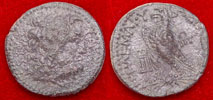
|
8196. EGYPT, PTOLEMY II, 285-246 BC. Tetradrachm of Tyre, S.7773. Portrait Ptolemy I/Eagle, TYP monogram above club. VF. A superior style portrait.
 $650. $650.
|
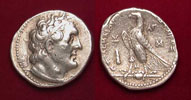 |
6557. KYRENE UNDER THE PTOLEMIES. AE38. Hd. Zeus r./Two eagles. F+. Rare.
SOLD.
| 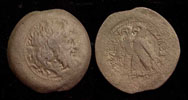 |
6556. PTOLEMAIC, UNCERTAIN. AR 24 mm Didrachm, 7.39 gm. Svoronos_, Copenhagen_.
Didemed hd. r./BASILEOUS (retrograde) PTOLEMAEOU, eagle stg. l. VF. Surface better than image. A very unusual coin, perhaps an imitative or unofficial product near the Arados mint. See Copenhagen 550-562 for the standard didrachms of this mint, c. 3rd-2nd century BC. Any additional information or attribution appreciated. Certainly very rare and interesting and deserving of further study.
SOLD.
|
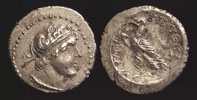 |
|
CLEOPATRA OF EGYPT
10475. SCARCE PORTRAIT COIN OF THE FAMOUS CLEOPATRA OF EGYPT. CLEOPATRA VII THEA NEOTERA, 51-30 BC, AE 21mm. Damaskos mint. Diademed and draped bust right. Reverse: Tyche seated left on rock, holding cornucopia; [to left, above sistrum(?); below, river god swimming right]; all within wreath. Svoronos 1893; RPC I 4783. F, black-green patina, rough. Rare. Considerably better than photo.
RR! Good F with good portrait for these.
SOLD.
|
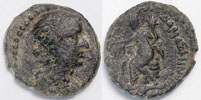
|
|
THE LARGEST GREEK COIN EVER STRUCK
10314. EGYPT, PTOLEMY II, 285-246 BC. AE46, ~93 g., Sear 7782. Laur. hd. Zeus Ammon r./Eagle stg. l. on thunderbolt looking back, E monogram between legs of eagle. VF. Nice example of this largest of the Ptolemaic bronze coins and one of the largest and heaviest ancient coins struck.
SOLD.
|
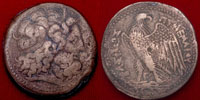
|
|
THE LARGEST GREEK COIN EVER STRUCK
10316. EGYPT, PTOLEMY II, 285-246 BC. AE47, ~97 g., Sear 7782. Laur. hd. Zeus Ammon r./Eagle stg. l. on thunderbolt looking back, E monogram between legs of eagle. VF. Nice example of this largest of the Ptolemaic bronze coins and one of the largest and heaviest ancient coins struck.
SOLD.
|
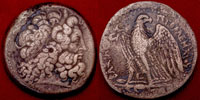
|
|
THE LARGEST GREEK COIN EVER STRUCK
10318. EGYPT, PTOLEMY II, 285-246 BC. AE46, ~97 g., Sear 7782. Laur. hd. Zeus Ammon r./Eagle stg. l. on thunderbolt looking back, E monogram between legs of eagle. VF. Nice example of this largest of the Ptolemaic bronze coins and one of the largest and heaviest ancient coins struck. SOLD.
|
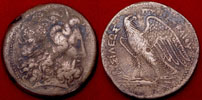
|
|
THE LARGEST GREEK COIN EVER STRUCK
10319. EGYPT, PTOLEMY II, 285-246 BC. AE46, ~90 g., Sear 7782. Laur. hd. Zeus Ammon r./Eagle stg. l. on thunderbolt looking back, E monogram between legs of eagle. VF. Nice example of this largest of the Ptolemaic bronze coins and one of the largest and heaviest ancient coins struck. SOLD.
|
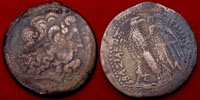
|
|
6556. PTOLEMAIC, UNCERTAIN. AR 24 mm Didrachm, 7.39 gm. Svoronos_, Copenhagen_.
Didemed hd. r./BASILEOUS (retrograde) PTOLEMAEOU, eagle stg. l. VF. Surface better than image. A very unusual coin, perhaps an imitative or unofficial product near the Arados mint. See Copenhagen 550-562 for the standard didrachms of this mint, c. 3rd-2nd century BC. Any additional information or attribution appreciated. Certainly very rare and interesting and deserving of further study.
|
 |
9380. EGYPT, ARSINOE II, wife of Ptolemy II, 285-246 BC. AR Dekadrachm of Alexandria, 35.08 gm, ca. 250 BC., Cf. Sotheby's Highly Important Greek and Roman Coins, 6/19/1990 #180. (The Nelson Bunker Hunt Sale), Sear 7770. Deified head of Arsinoe r. wearing stephane and veil, lotus-tipped scepter over l. shoulder appearing again at top of head/Filleted double cornucopia with grape clusters. F+. Very rare. The Sotheby's description notes that the Arsinoe dekadrachm is the first representation of a female monarch in numismatic art and that Arsinoe the sister and wife of Ptolemy II was so influential that she was deified after her death and that her cult became very popular. Chance to own a dekadrachm inexpensively! The coin is better than the image, especially the obverse portrait.
SOLD.
|

|
|
10348. A VERY RARE PTOLEMAIC BRONZE. EGYPT, PTOLEMY II?, c. 260 BC. Middle Eastern? mint. AE19, 5.94 g. 12h. Svoronos 792 (Plate XXV, #22), BMC 65, #29. Svoronos knew only the single BMC example. Laur. hd. Zeus Ammon right. Reverse: Eagle standing left on thunderbolt looking left, tripod to left and Π-T-O monogram to right of eagle. VF. Nice dark glossy green patina. Much better than photo. Only a few examples known. Very rare and missing from most collections.
Svoronos attributes these to Ptolemy II but the details, of style, and lettering suggest even Ptolemy III or even Ptolemy V. The eagle is similar to those on Ptolemy V portrait tetradrachms. The Ptolemy V coins with NI controls are said to be from 'military mints' of the 4th or 5th Syrian war. Perhaps this tripod type has a similar origin (middle East) while the others (791, 793) are believed to come from Western Turkey (Bodrum, Fethiye). Richard Ashton wrote an article on those arguing for the Turkish mints. The Ashton paper on coins at Fethiye (turkey) does not include these types. The 791 and 793 are plentiful there but not 792 with the Π-T-O symbol. Interesting also that a couple of earlier issue Ptolemaic bronzes are known with a tripod countermark and perhaps are related to these. One is a Tyre coin of Ptolemy III, the other of Ptolemy IV.
SOLD.
|
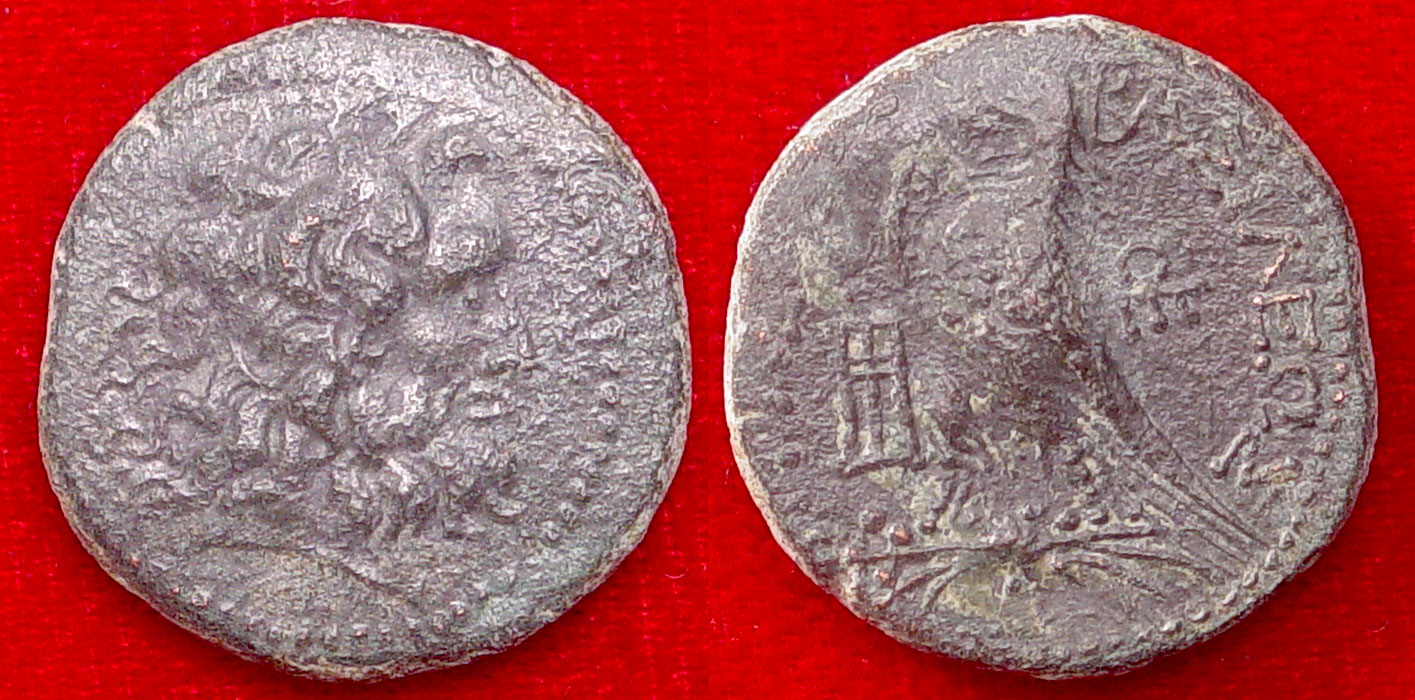
|
|
10352. A VERY RARE PTOLEMAIC BRONZE. EGYPT, PTOLEMY II?, c. 260 BC. Middle Eastern? mint. AE19, 6.68 g. 12h. Svoronos 792 (Plate XXV, #22), BMC 65, #29. Svoronos knew only the single BMC example. Laur. hd. Zeus Ammon right. Reverse: Eagle standing left on thunderbolt looking left, tripod to left and Π-T-O monogram to right of eagle. VF. Nice dark glossy green patina. Much better than photo. Only a few examples known. Very rare and missing from most collections.
Svoronos attributes these to Ptolemy II but the details, of style, and lettering suggest even Ptolemy III or even Ptolemy V. The eagle is similar to those on Ptolemy V portrait tetradrachms. The Ptolemy V coins with NI controls are said to be from 'military mints' of the 4th or 5th Syrian war. Perhaps this tripod type has a similar origin (middle East) while the others (791, 793) are believed to come from Western Turkey (Bodrum, Fethiye). Richard Ashton wrote an article on those arguing for the Turkish mints. The Ashton paper on coins at Fethiye (turkey) does not include these types. The 791 and 793 are plentiful there but not 792 with the Π-T-O symbol. Interesting also that a couple of earlier issue Ptolemaic bronzes are known with a tripod countermark and perhaps are related to these. One is a Tyre coin of Ptolemy III, the other of Ptolemy IV.
SOLD.
|
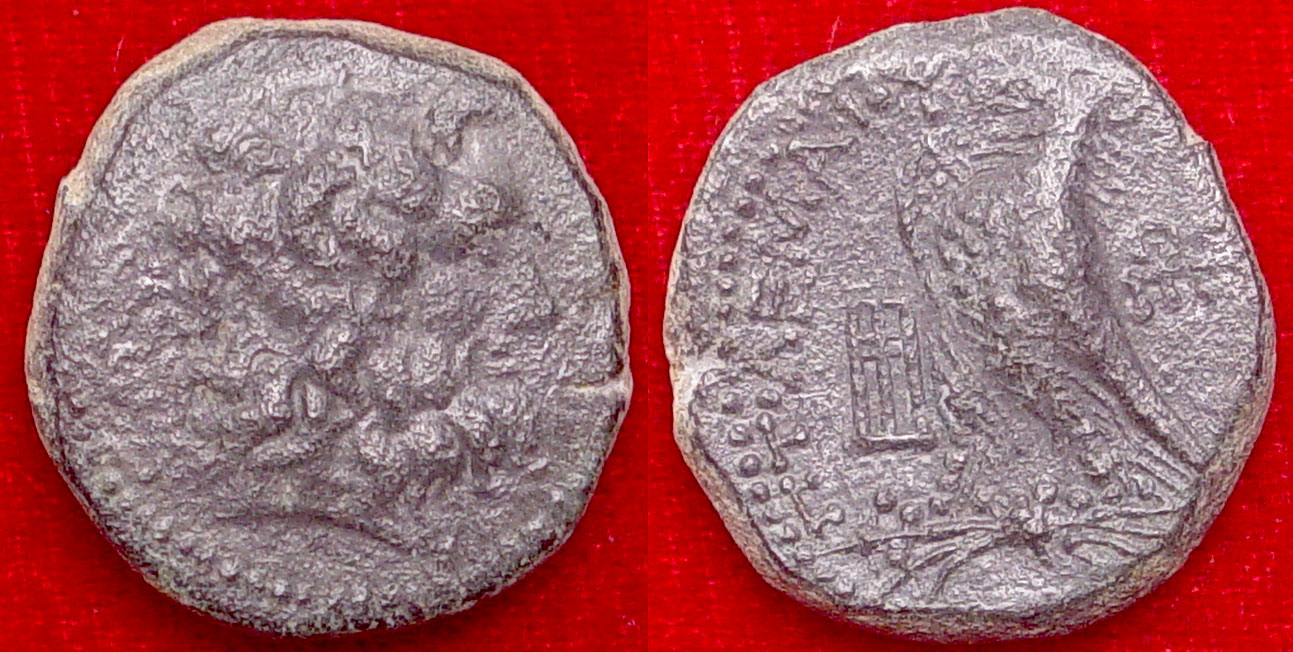
|
|
10354. A VERY RARE PTOLEMAIC BRONZE. EGYPT, PTOLEMY II?, c. 260 BC. Middle Eastern? mint. AE17, 4.97 g. 12h. Svoronos 792 (Plate XXV, #22), BMC 65, #29. Svoronos knew only the single BMC example. Laur. hd. Zeus Ammon right. Reverse: Eagle standing left on thunderbolt looking left, tripod to left and Π-T-O monogram to right of eagle. VF. Nice dark glossy green patina. Much better than photo. Only a few examples known. Very rare and missing from most collections.
Svoronos attributes these to Ptolemy II but the details, of style, and lettering suggest even Ptolemy III or even Ptolemy V. The eagle is similar to those on Ptolemy V portrait tetradrachms. The Ptolemy V coins with NI controls are said to be from 'military mints' of the 4th or 5th Syrian war. Perhaps this tripod type has a similar origin (middle East) while the others (791, 793) are believed to come from Western Turkey (Bodrum, Fethiye). Richard Ashton wrote an article on those arguing for the Turkish mints. The Ashton paper on coins at Fethiye (turkey) does not include these types. The 791 and 793 are plentiful there but not 792 with the Π-T-O symbol. Interesting also that a couple of earlier issue Ptolemaic bronzes are known with a tripod countermark and perhaps are related to these. One is a Tyre coin of Ptolemy III, the other of Ptolemy IV.
SOLD.
|
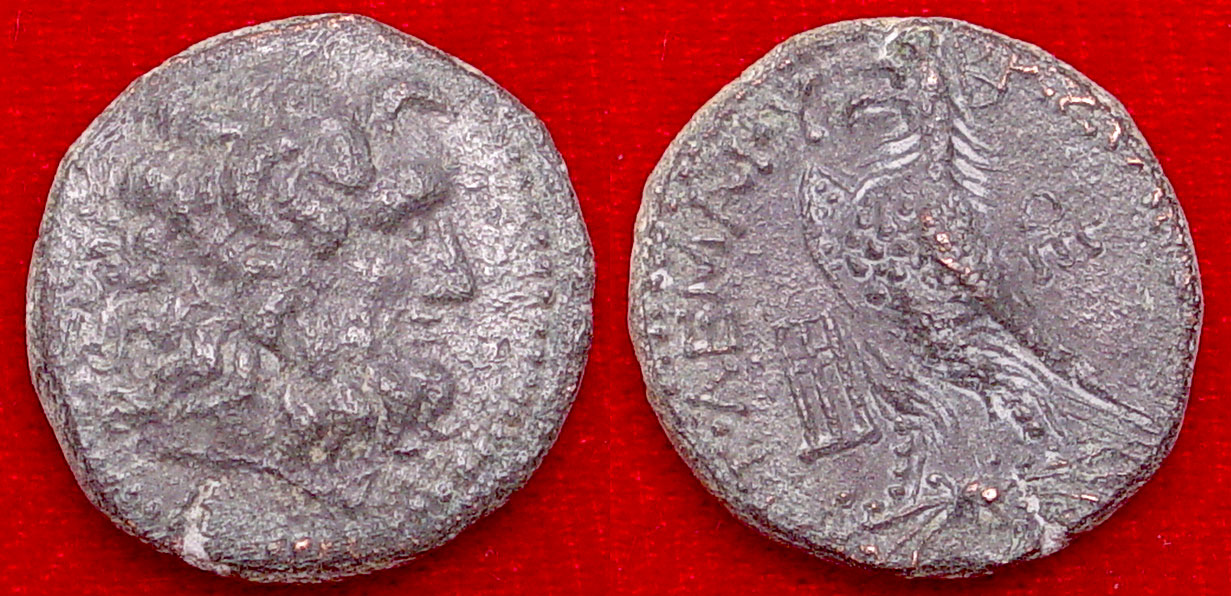
|
10315. EGYPT, PTOLEMY II, 285-246 BC. AE48, ~98 gm. Sear 7782. Laur. hd. Zeus Ammon r./Eagle stg. l. on thunderbolt looking back, E monogram between legs of eagle. VF. Nice example of this largest of the Ptolemaic bronze coins and one of the largest and heaviest ancient coins struck.
SOLD.
|

|
10320. EGYPT, PTOLEMY II, 285-246 BC. AE48, ~92 gm. Sear 7782. Laur. hd. Zeus Ammon r./Eagle stg. l. on thunderbolt looking back, E monogram between legs of eagle. VF. Nice example of this largest of the Ptolemaic bronze coins and one of the largest and heaviest ancient coins struck.
SOLD.
|
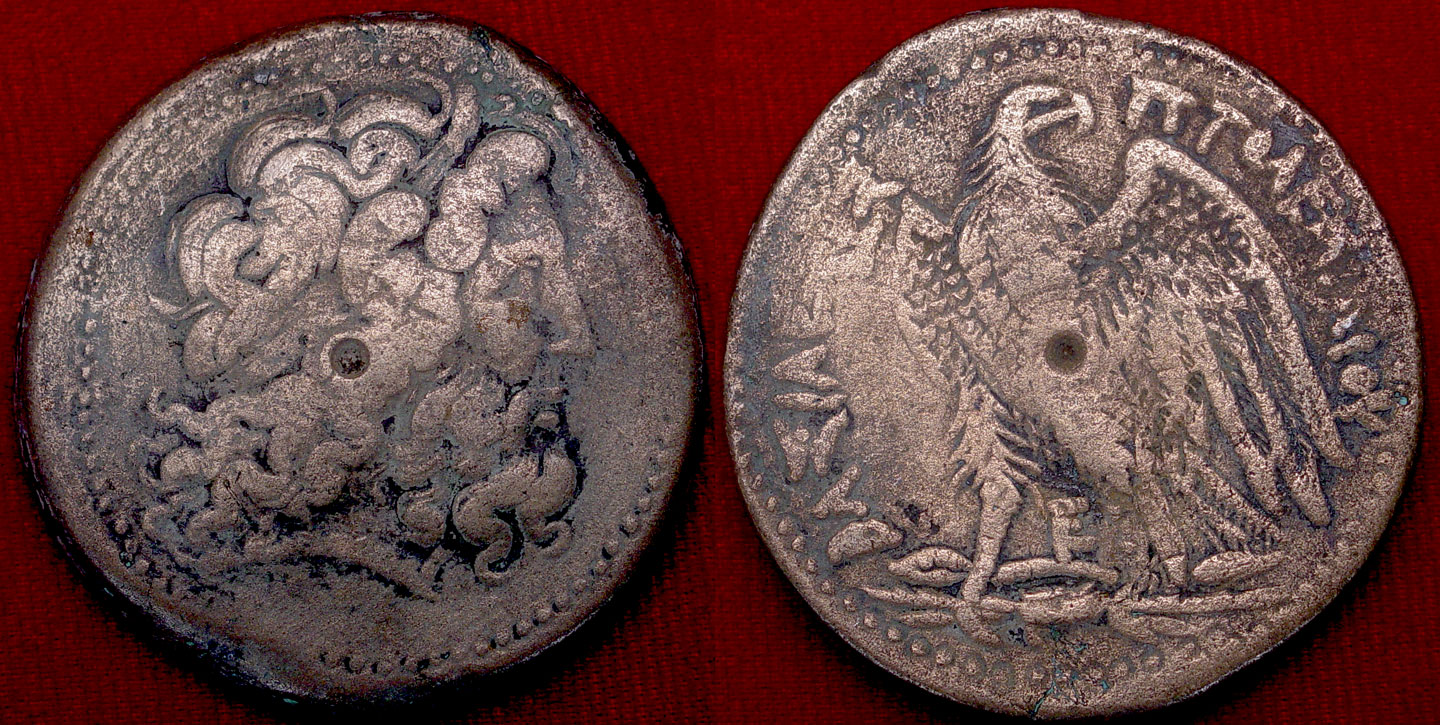
|
10321. EGYPT, PTOLEMY II, 285-246 BC. AE46, ~100 g., Sear 7782. Laur. hd. Zeus Ammon r./Eagle stg. l. on thunderbolt looking back, E monogram between legs of eagle. VF. Nice example of this largest of the Ptolemaic bronze coins and one of the largest and heaviest ancient coins struck.
SOLD.
|

|
An exceptional offering of 8 very rare Ptolemaic bronzes. Including these 8 only 10 are known including one in the British Museum.
|
10349. A VERY RARE PTOLEMAIC BRONZE. EGYPT, PTOLEMY II?, c. 260 BC. Middle Eastern? mint. AE21, 12h. Svoronos 792 (Plate XXV, #22), BMC 65, #29. Svoronos knew only the single BMC example. Laur. hd. Zeus Ammon right. Reverse: Eagle standing left on thunderbolt looking left, tripod to left and Π-T-O monogram to right of eagle. VF. Nice dark glossy green patina. Much better than photo. Only a few examples known. Very rare and missing from most collections.
Svoronos attributes these to Ptolemy II but the details, of style, and lettering suggest even Ptolemy III or even Ptolemy V. The eagle is similar to those on Ptolemy V portrait tetradrachms. The Ptolemy V coins with NI controls are said to be from 'military mints' of the 4th or 5th Syrian war. Perhaps this tripod type has a similar origin (middle East) while the others (791, 793) are believed to come from Western Turkey (Bodrum, Fethiye). Richard Ashton wrote an article on those arguing for the Turkish mints. The Ashton paper on coins at Fethiye (turkey) does not include these types. The 791 and 793 are plentiful there but not 792 with the Π-T-O symbol. Interesting also that a couple of earlier issue Ptolemaic bronzes are known with a tripod countermark and perhaps are related to these. One is a Tyre coin of Ptolemy III, the other of Ptolemy IV.
SOLD.
|
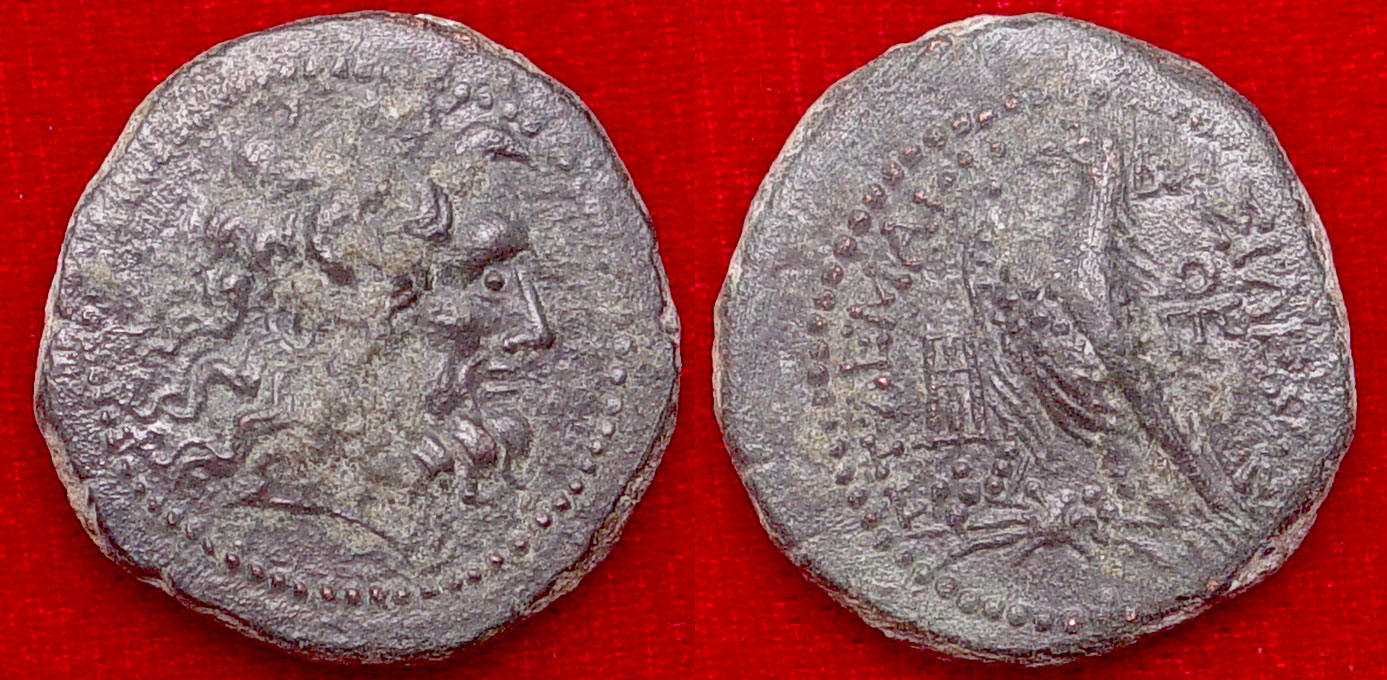
|
|
10350. A VERY RARE PTOLEMAIC BRONZE. EGYPT, PTOLEMY II?, c. 260 BC. Middle Eastern? mint. AE18, 12h. Svoronos 792 (Plate XXV, #22), BMC 65, #29. Svoronos knew only the single BMC example. Laur. hd. Zeus Ammon right. Reverse: Eagle standing left on thunderbolt looking left, tripod to left and Π-T-O monogram to right of eagle. VF. Nice dark glossy green patina. Much better than photo. Only a few examples known. Very rare and missing from most collections.
Svoronos attributes these to Ptolemy II but the details, of style, and lettering suggest even Ptolemy III or even Ptolemy V. The eagle is similar to those on Ptolemy V portrait tetradrachms. The Ptolemy V coins with NI controls are said to be from 'military mints' of the 4th or 5th Syrian war. Perhaps this tripod type has a similar origin (middle East) while the others (791, 793) are believed to come from Western Turkey (Bodrum, Fethiye). Richard Ashton wrote an article on those arguing for the Turkish mints. The Ashton paper on coins at Fethiye (turkey) does not include these types. The 791 and 793 are plentiful there but not 792 with the Π-T-O symbol. Interesting also that a couple of earlier issue Ptolemaic bronzes are known with a tripod countermark and perhaps are related to these. One is a Tyre coin of Ptolemy III, the other of Ptolemy IV.
SOLD.
|
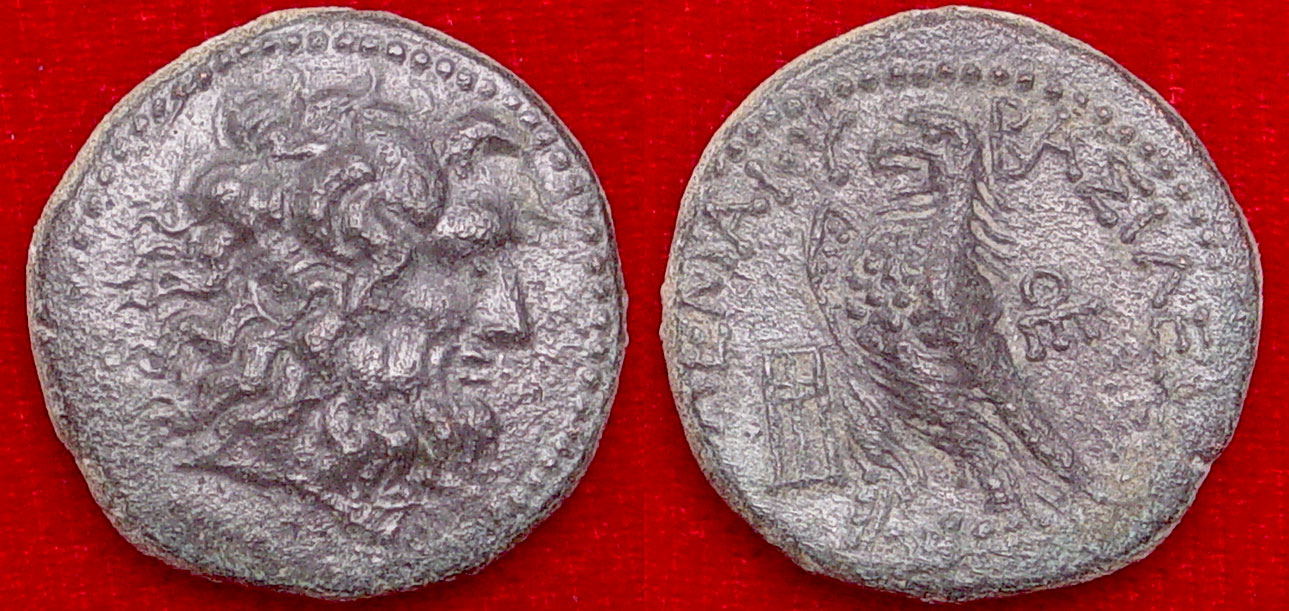
|
|
10351. A VERY RARE PTOLEMAIC BRONZE. EGYPT, PTOLEMY II?, c. 260 BC. Middle Eastern? mint. AE20, 9.54 g. 12h. Svoronos 792 (Plate XXV, #22), BMC 65, #29. Svoronos knew only the single BMC example. Laur. hd. Zeus Ammon right. Reverse: Eagle standing left on thunderbolt looking left, tripod to left and Π-T-O monogram to right of eagle. VF. Nice dark glossy green patina. Much better than photo. Only a few examples known. Very rare and missing from most collections.
Svoronos attributes these to Ptolemy II but the details, of style, and lettering suggest even Ptolemy III or even Ptolemy V. The eagle is similar to those on Ptolemy V portrait tetradrachms. The Ptolemy V coins with NI controls are said to be from 'military mints' of the 4th or 5th Syrian war. Perhaps this tripod type has a similar origin (middle East) while the others (791, 793) are believed to come from Western Turkey (Bodrum, Fethiye). Richard Ashton wrote an article on those arguing for the Turkish mints. The Ashton paper on coins at Fethiye (turkey) does not include these types. The 791 and 793 are plentiful there but not 792 with the Π-T-O symbol. Interesting also that a couple of earlier issue Ptolemaic bronzes are known with a tripod countermark and perhaps are related to these. One is a Tyre coin of Ptolemy III, the other of Ptolemy IV.
SOLD.
|
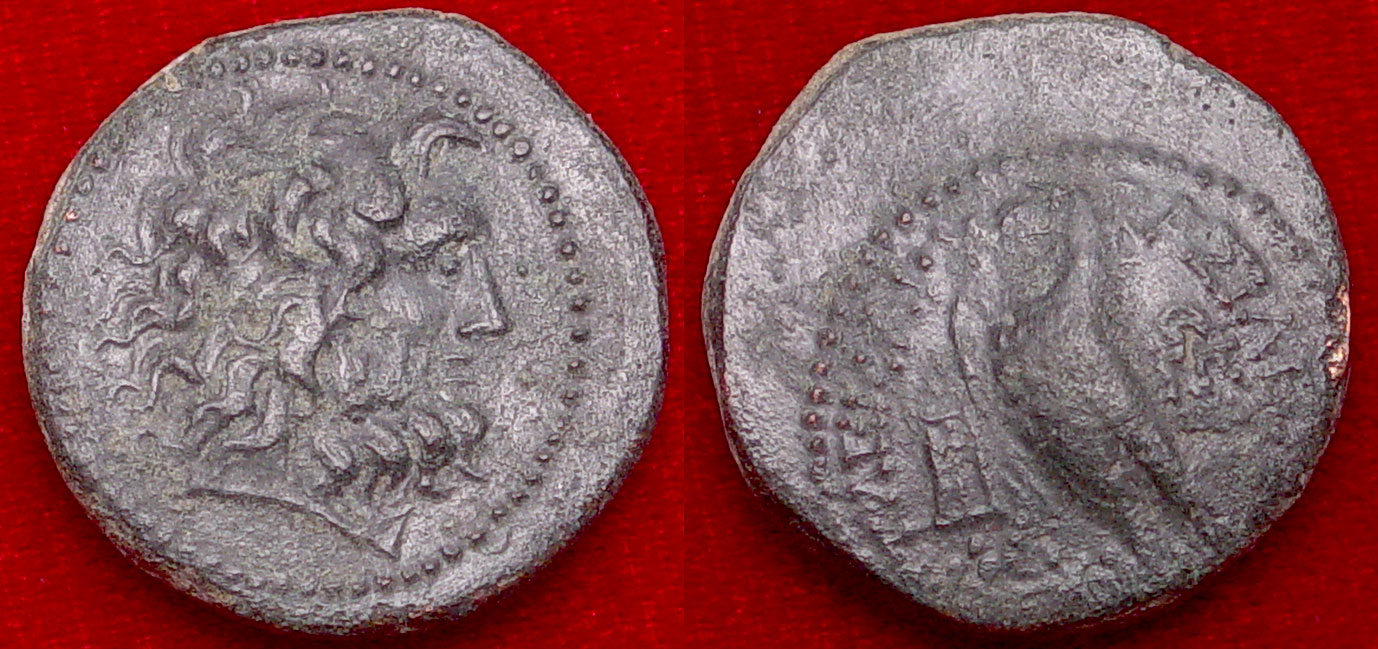
|
ARSINOE I, first wife of Ptolemy II, daughter of Lysimachos
ARSINOE II, daughter of Ptolemy I, wife of Lysimachos, sister and second wife of Ptolemy II
PTOLEMY III, EUERGETES, 246-222
BERENIKE II, wife of Ptolemy III
PTOLEMY IV, PHILOPATOR, 221-204
PTOLEMY V, EPIPHANES, 204-180
CLEOPATRA I, wife of Ptolemy V, daughter of Antiochos III,
CLEOPATRA II, sister and wife of Ptolemy VI, then sister and wife of Ptolemy VIII
PTOLEMY VII, NEOS PHILOPATOR, 145-144. son of Ptolemy VI and Cleopatra II
PTOLEMY VIII, EUERGETES, 145-116, younger brother of Ptolemy VI
CLEOPATRA III, second wife of Ptolemy VIII, daughter of Ptolemy VI and Cleopatra II
PTOLEMY IX, SOTER, 116-106 and 88-80, oldest son of Ptolemy VIII and Cleopatra III
PTOLEMY X, ALEXANDER, 106-88, youngest son of Ptolemy VIII and Cleopatra III
PTOLEMY XI, 80, son of Ptolemy X by his unknown first wife
PTOLEMY XII, NEOS DIONYSOS, 80-58 and 55-51, son of Ptolemy IX by a Greek concubine
CLEOPATRA VII, THEA NEOTERA, 51-30, lover of Julius Caesar and Marc Antony, daughter of Ptolemy XII and Cleopatra VI, (issues with Marc Antony are to be found on our Roman Imperatorial coins page)
PTOLEMY XIII, 51-47, brother of Cleopatra VII and temporary co-ruler with her
PTOLEMY XIV, 47-44, brother of Cleopatra VII and temporary co-ruler with her
PTOLEMY XV, CAESARION, 44-30, son of Cleopatra VII and Julius Caesar, temporary co-ruler with his mother
PTOLEMY, UNATTRIBUTED
6556. PTOLEMAIC, UNCERTAIN. AR 24 mm Didrachm, 7.39 gm. Svoronos_, Copenhagen_.
Didemed hd. r./BASILEOUS (retrograde) PTOLEMAEOU, eagle stg. l. VF. Surface better than image. A very unusual coin, perhaps an imitative or unofficial product near the Arados mint. See Copenhagen 550-562 for the standard didrachms of this mint, c. 3rd-2nd century BC. Any additional information or attribution appreciated. Certainly very rare and interesting and deserving of further study.
SOLD.
|
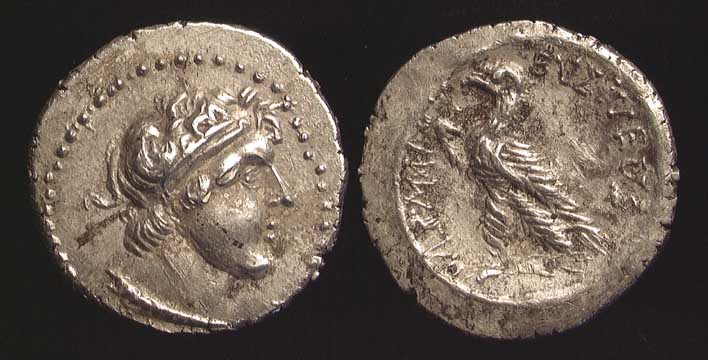 |
7480. PTOLEMAIC SILVER TETRADRACHM. Egypt, 3rd-2nd century BC. Diademed hd. of a Ptolemy r./Eagle stg. l. on thunderbolt.
SOLD.
|
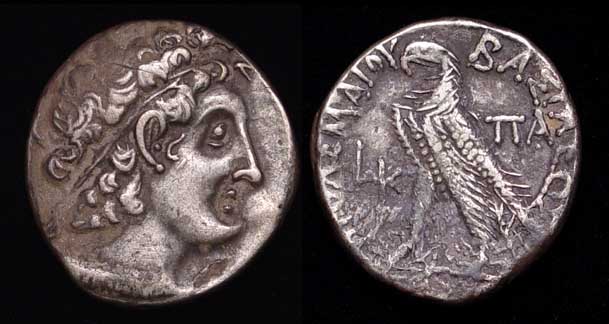 |
7481. PTOLEMAIC SILVER TETRADRACHM. Egypt, 3rd-2nd century BC. Diademed hd. of a Ptolemy r./Eagle stg. l. on thunderbolt.
SOLD.
|
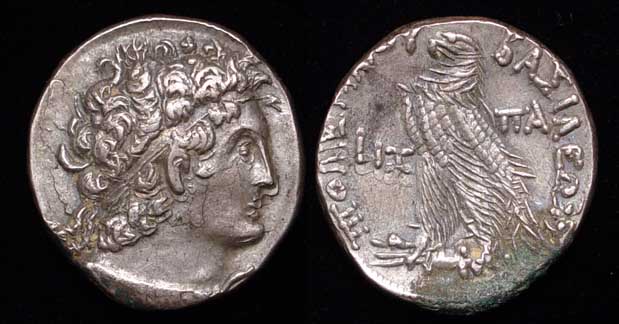 |
7482. PTOLEMAIC SILVER TETRADRACHM. Egypt, 3rd-2nd century BC. Diademed hd. of a Ptolemy r./Eagle stg. l. on thunderbolt.
SOLD.
|
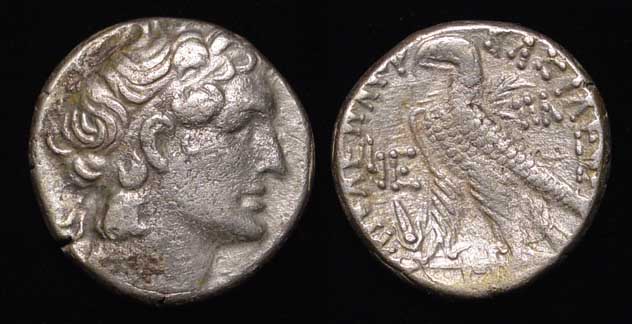 |
7483. PTOLEMAIC SILVER TETRADRACHM. Egypt, 3rd-2nd century BC. Diademed hd. of a Ptolemy r./Eagle stg. l. on thunderbolt.
SOLD.
|
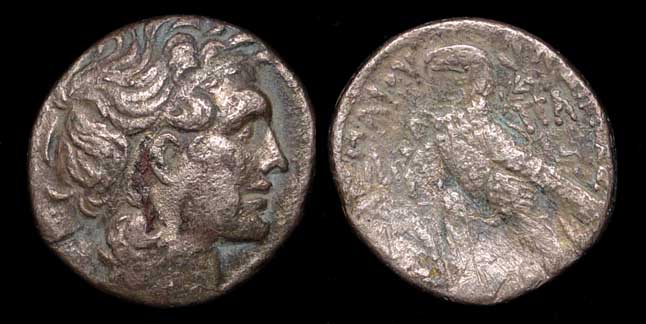 |
7484. PTOLEMAIC SILVER TETRADRACHM. Egypt, 3rd-2nd century BC. Diademed hd. of a Ptolemy r./Eagle stg. l. on thunderbolt.
SOLD.
|
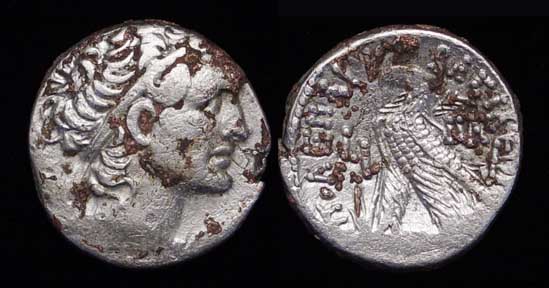
|
KYRENE
6557. KYRENE UNDER THE PTOLEMIES. AE38. Hd. Zeus r./Two eagles. F+. Rare.
SOLD.
| 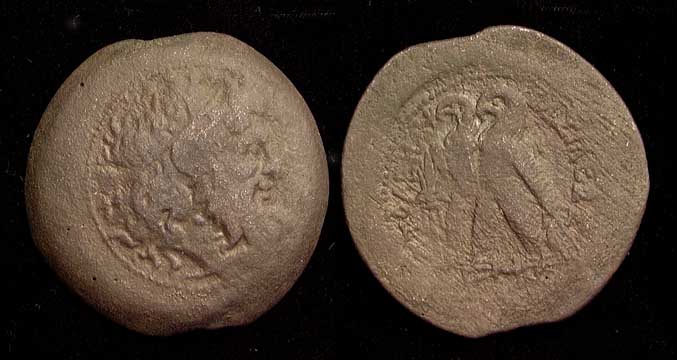 |
HOME >
GALLERIES >
TOP




























